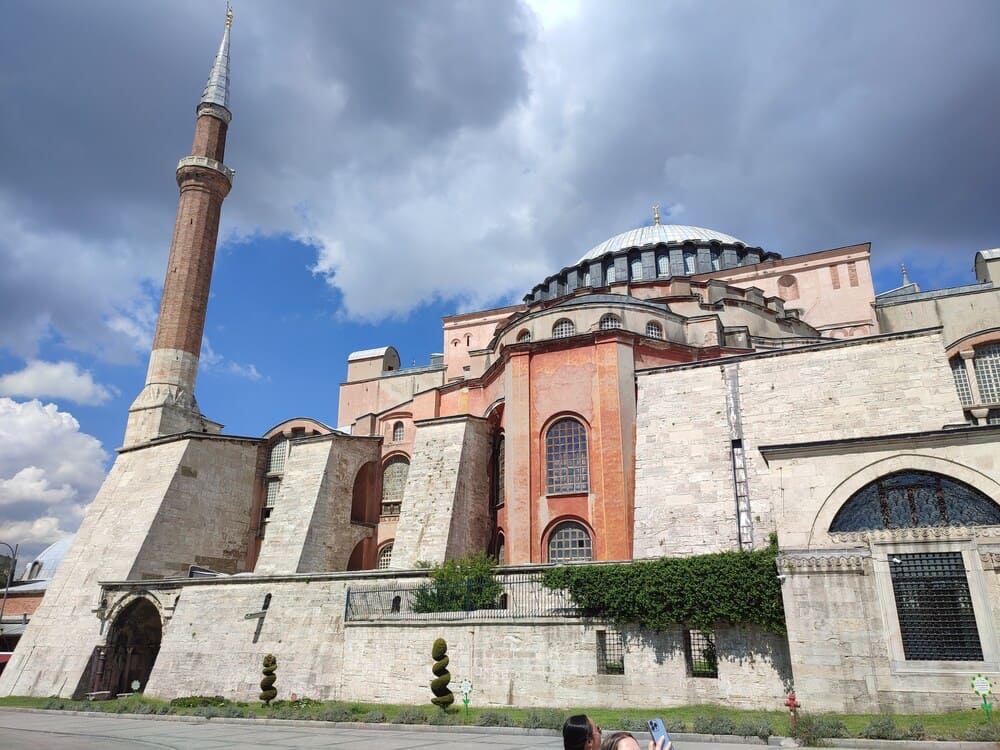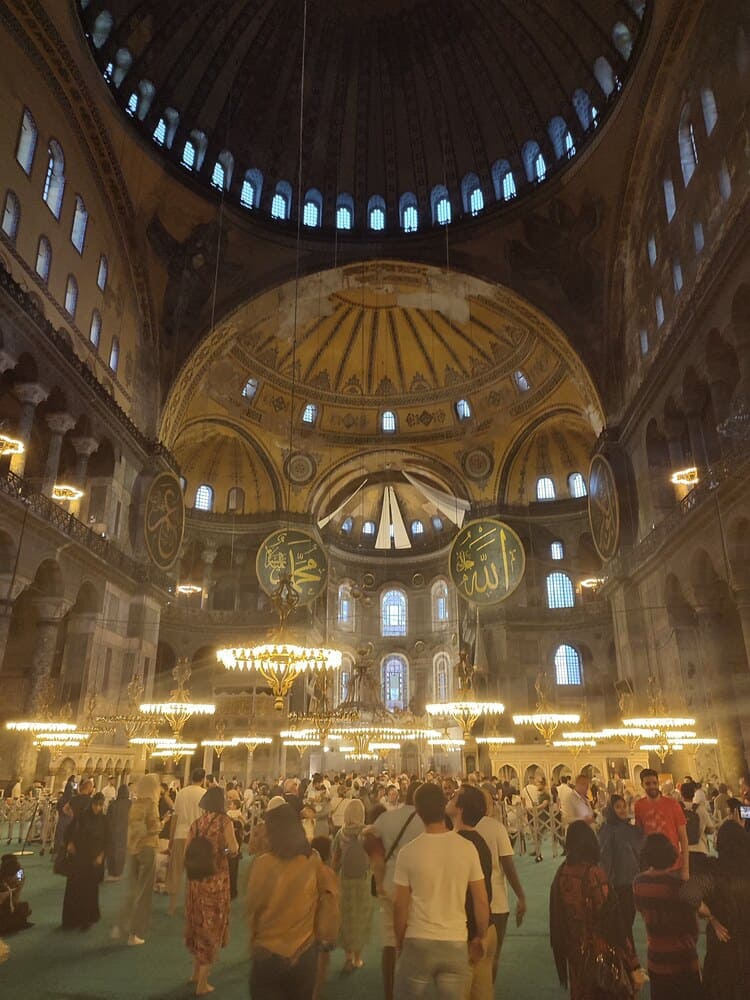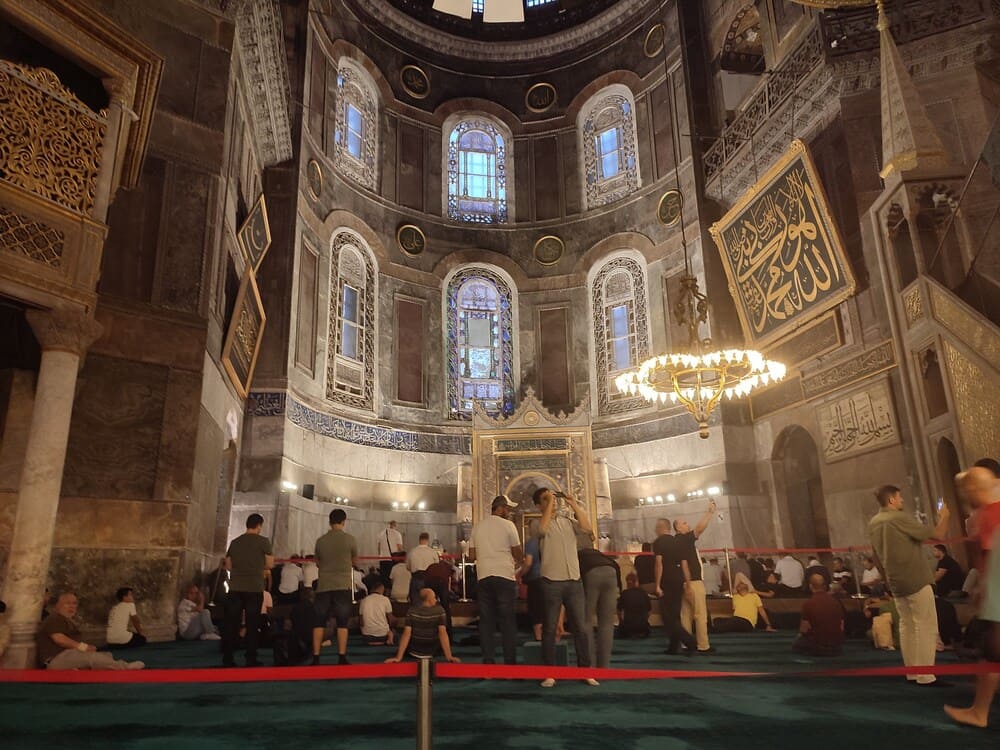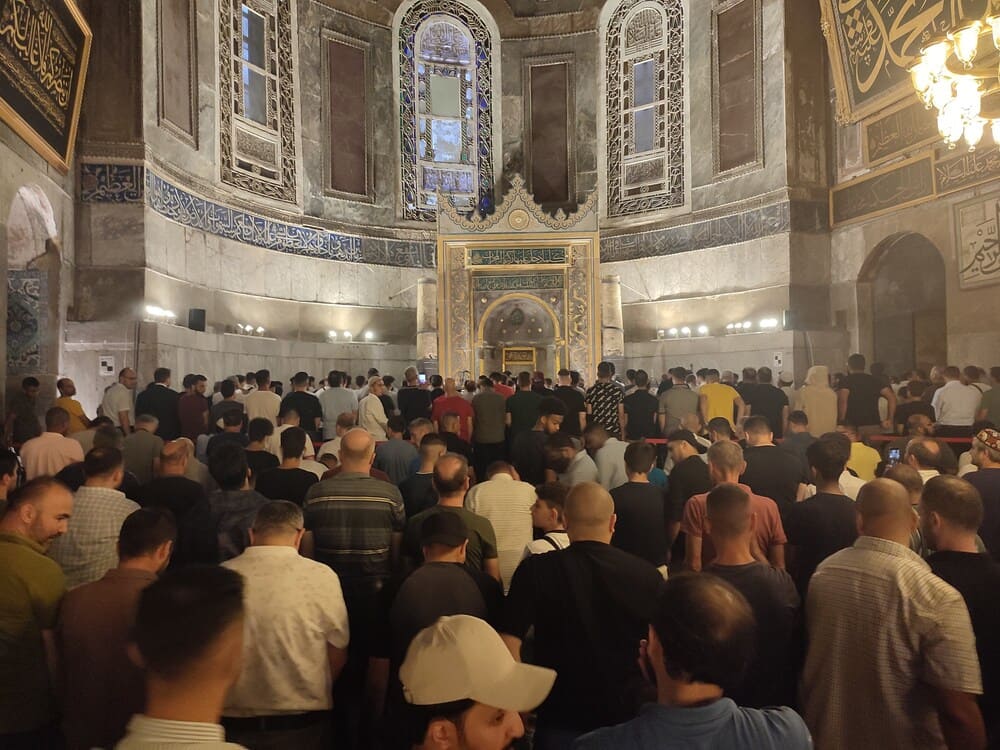Can You Pray in Hagia Sophia? (2024)
Hagia Sophia is the most recognizable landmark in Istanbul and I dare say all of Turkey. Dating from the 6th century, it’s almost as old as the city it’s in. Its status has changed multiple times:
- 537 AD – Church (largest cathedral until 1520!)
- 1453 – Transformed into a Mosque
- 1931 – Closed
- 1934 – Reopened as a Museum by Mustafa Kemal Ataturk
- 2020 – Mosque status restored again. Free entrance for all
- 2024 – Mosque on ground floor, museum on upper-floor galleries. Free for Muslims, paid for tourists.
Rules changed significantly in January 2024. There are now two entrances to Hagia Sophia: one for Muslims intending to pray and one for non-muslims that leads to the upper gallery.
Entrance is free for Muslims and the five daily prayers are done in the Prayer Area (called İbadethane) on the ground floor of Hagia Sophia. Entry is through Sultanahmet Square where it’s been since 2020.
For tourists, the entrance fee is 25 euro (850 TL but may increase with inflation). Entry is from the Visiting Area entrance at the northeast corner of Hagia Sophia. Buy a ticket from the ticket booth in front of the Fountain of Sultan Ahmet III or book a skip-the-line ticket online.

Can you pray in Hagia Sophia if you’re Muslim?
Yes, you can pray in Hagia Sophia as a Muslim. The 5 daily prayers are performed according to the official times depending on the position of the sun in Istanbul.
Check them the Muslim Prayer Times here.
Muslim Prayer Times
Muslims pray 5 times a day at variable times depending on their location on Earth and the time of year. These are:
- Fajr (dawn, 2 Rak’ah)
- Dhuhr (midday, 4 Rak’ah)
- Asr (afternoon, 4 Rak’ah)
- Maghrib (sunset, 3 Rak’ah)
- Isha (night, 4 Rak’ah)
The Muslim prayer is called salah. Every salah is performed with several Rak’ahs – a single iteration of movements and prayer chants.
Depending on which salah it is, there is a different number of Rak’ahs for each prayer as shown above.

Hagia Sophia Imams
Prayer in Hagia Sophia is led by an Imam. When it reopened as a mosque in 2020, three Imams were appointed:
- Mehmet Boynukalin, a professor of Islamic law at Istanbul’s Marmara University;
- Ferruh Mustuer, a renowned imam and hafiz (a memorizer of the Quran);
- Bunyamin Topcuoglu, a long-term Imam of other Istanbul mosques.
The Rope
The Rope no longer exists, as the prayer area is off-limits for non-Muslims.
During the Islamic prayers, there is a rope separating the front prayer portion of Hagia Sophia. Attendants urge all visitors who won’t partake in the prayer to go behind the rope.

Can Muslim women pray in Hagia Sophia?
Yes, Muslim women are welcome to pray in a separate portion of Hagia Sophia.
Women are NOT allowed to pray together with men on the ground floor right in front of the mihrab.

Can you pray in Hagia Sophia if you’re Christian?
There are no organized Christian prayers in Hagia Sophia.
Moreover, since 15 January 2024, all non-Muslims must buy an entrance ticket and enter from a different entrance that only allows access to the gallery floor of Hagia Sophia.
This means it’s no longer possible to pray as a Christian in Hagia Sophia.
Before that, it was theoretically possible to individually and quietly pray as a Christian on the ground floor. There are Christian mosaics and icons on the walls after all.
These mosaics are supposed to be covered during the Muslim prayers (depictions of living things are not allowed in Islam because only Allah can create life), but when I was there (August 2022) nothing was covered during the Maghrib.
Can you visit Hagia Sophia if you don’t want to pray?
Yes, you can visit Hagia Sophia even if you don’t want to pray.
Hagia Sophia is open to non-Muslim visitors every day from 09:00 am to 7:30 pm. On Friday, the mosque is closed to non-Muslim visitors between 12:30-14:30 due to the Friday Prayer (Salatul-Jumu’ah).
Tourists can only visit the second floor of the Mosque where the gallery is. You will be able to see the ground floor from above but will, unfortunately, miss out on most of the amazing artwork and mosaics on the walls.
Note that professional tour guides are no longer allowed to tour visitors.
My experience praying at Hagia Sophia
The following story is from August 2022 when it was possible to enter the ground floor regardless of your religion.
I went to visit Hagia Sophia about 15 minutes before Maghrib, the sunset prayer. There was no queue of people trying to enter and thus no waiting in the scorching summer sun that many endure when they go during the day.
Five minutes into my entering Hagia Sophia the attendants stretched the rope and urged all visitors to go behind it. That was when I made the split-second decision to go past the rope and join the crowd of Muslims.
So there I am, having overstepped the limits of my piety, both literally and figuratively. I am not a Muslim and although I know a lot about Islam, I don’t follow its rules and have never prayed.
It was another 5 minutes of people gathering, some already doing their prayers, others chatting and the occasional lost tourist who’s still snapping pics like he’s a paparazzi at the Oscars – I swear, that wasn’t me.

Out of a sudden, everyone starts walking forward and I am already too deep in to go back so I just join the crowd.
Standing shoulder to shoulder, facing the mihrab (the niche in the wall that points towards Mecca), listening to the Imam (Muslims can pray without him, he just knows the Quran pretty well and leads the prayers).
Everyone says Amin and so do I. Everyone kneels and so do I. We bow, my neighbors mumble prayers, and we stand up again. Repeat that 3 times. Did I just pray?
There’s nobody between man and God in Islam. Everyone can pray and you aren’t judged on your piety by others. However, one must pray in Arabic, so no matter how earnest you are in your submission to Allah, you won’t be performing the Quranic Salah if it’s in your native tongue.
Is it worth paying the entrance fee for Hagia Sophia in 2024?
The entrance fee to Hagia Sophia as a non-Muslim is a whopping 25 euros (or however much it is in Turkish Lira at the time).
For a quick comparison, the Louvre in Paris is 17 euros, the Rijksmuseum in Amsterdam is 20 euros, and Tower Bridge in London is around 14.5 euros.
Is the excessively high entrance fee for Hagia Sophia deserved? I think not.
It’s deliberate. It’s a way to control how many people enter. 3.7 million entered in 2019 when it was paid which increased to 13.6 million in 2022 when it was free (and mind you, Pandemic times were not fully over yet).
Is Hagia Sophia worth the high entrance fee? Honestly, I don’t think so.
It’s a marvelous landmark with deep historical and religious significance and a storied history of emperors, popes, and sultans.
But you can visit the just-as-marvelous Sultanahmed Mosque nearby (the Blue Mosque) and the Suleymaniye Mosque within walking distance away FOR FREE.
Moreover, you aren’t even allowed to walk on the ground floor.
Save your money and have some delicious Turkish food or go to a hammam instead.

